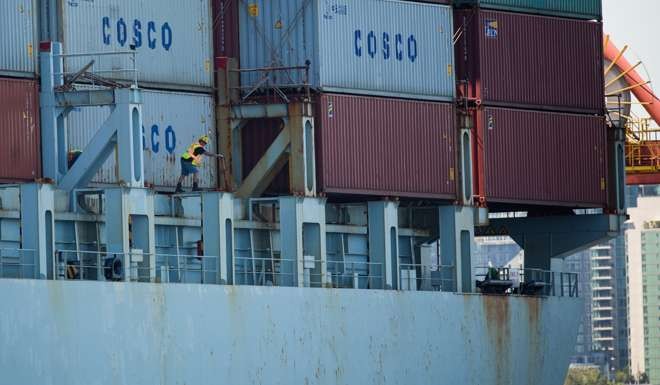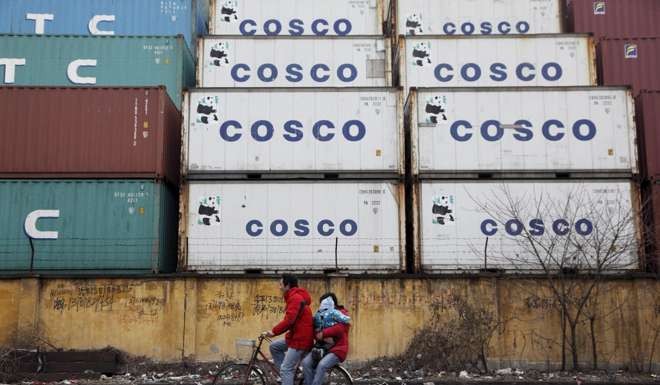
Shipping sector set for choppy waters ahead as freight rates stay volatile, says UBS
Donald Trump’s anti-trade stand poses biggest risk for struggling industry, analyst says

Cosco Shipping, China’s largest shipping firm has warned that it expects to post a nearly 10 billion yuan net loss for 2016, only a week after announcing plans to buy a substantial stake in Qingdao Port for 5.8 billion yuan.
The firm late on Wednesday said in a stock exchange filing that it expects to report a 9.9 billion yuan net loss for 2016, although it estimated a profit before tax and interest of 700 million yuan was booked in the fourth quarter when vessels demotion costs were excluded.
It blamed ongoing oversupply in global shipping capacity and slow demand growth for the loss.
It made a net profit of 283.4 million yuan in 2015.
Its shares listed in Hong Kong closed at HK$2.95 on Thursday, and have risen 10.5 per cent from a month earlier.
The shipping giant’s performance typifies a global shipping sector facing major challenges in 2017 as it charts its way out of a financial crisis, caused by a drop in container fleets despite a growing demand for business, according to new research from UBS.
Freight rates – the price shipping companies charge for delivering cargo – are expected to remain volatile, however, while rising protectionism globally poses longer-term threats to the industry, analysts say.
UBS equity analyst Eric Lin says the biggest uncertainty for companies is whether newly-elected US President Donald Trump will turn the anti-trade rhetoric he freely used throughout his campaign into concrete policies.
“Trump is the biggest risk to the industry right now,” Lin told the South China Morning Post.
“While we are unable to quantify the impact at this moment, it will certainly be negative.”
Trump has vowed to bring manufacturing jobs back to the US by imposing punitive tariffs on imports most notably China and Mexico, triggering major concerns of a shrinking in trade globally.

On Monday, the new president withdrew the US from the Trans-Pacific Partnership, a free-trade pact aiming to strengthen economic ties among 12 Pacific-rim nations. He also wants to renegotiate a free trade agreement between the US, Canada and Mexico to make US businesses more competitive.
With such looming policy uncertainty, analysts maintain a “Sell” rating for China’s COSCO Shipping Holdings, for instance, citing low profit margins compared to its global rivals.
It blamed the profit warning on ongoing oversupply in global shipping capacity and slow demand growth for the loss. It made a net profit of 283.4 million yuan in 2015.
In March 2016, COSCO completed its mega merger with China Shipping Group, in the government’s latest effort to consolidate the industry and make its shipping industry more competitive.
Investors had priced in the merger, but COSCO is still unlikely to be turning a profit before 2018, according to UBS.
UBS now expects global container shipping volume to increase by around 3.7 per cent in 2017 despite slowing economic growth in China, the world’s largest trading nation.
However, UBS’ analysts led by Dominic Edridge warns too that a recent recovery in freight rates might not be sustainable, with a large number of vessels expected to start taking orders soon.
Container shipping capacity had been growing annually by an average of 3 per cent faster than demand since 2008, resulting in an accumulation of excess supply, he said.

“We believe that oversupply remains in the system and is likely to take multiple years of demand being greater than supply to fully correct this situation,” Edridge said.
The financial crisis caused a slump in freight rates. To avoid losses, many ship owners chose to lay up their vessels, temporarily taking them off service and putting their crew on leave.
Around 7 per cent of the fleet is still currently sitting idle, many of them modern, large vessels, and competition would intensify if some return to the market this year, according to the UBS report.
Many ship buyers also deferred new vessel deliveries, which has contributed to the price rebound.
The temporary recovery is not going to help much in 2017. A total of 40 vessels were due for delivery in January alone, likely to cause downturn pressure to freight rates, the report said.
On the positive side, several new vessel regulations set by international organisations could help trim the fleets.
For example, an International Maritime Organisation convention will come into force this year requiring ships to be equipped with ballast water-treatment systems.
Ships take on and discharge ballast water to maintain stability at sea. But meantime, invasive species and pollutants in the water can be spread from one place to another.
Facing with high costs of meeting such requirements, over 60 per cent of vessel owners intend scrapping their older vessels, according to another UBS published in January.
“This should help recovery in areas of the world fleet where there are a large number of older, and therefore, more vulnerable vessels,” that survey concluded.
Although the capacity glut remains, many industry players believe the worst times are over, however. In November, the average confidence level in the global shipping sector was 5.6 out of 10.0, according to a survey by accounting firm Moore Stephens — that’s the highest since August 2015.